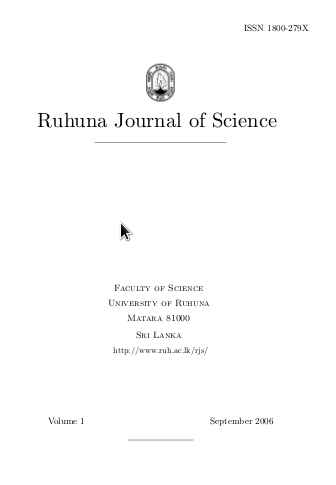Preliminary study on cytotoxic compounds from the seeds of Nigella sativa L (Black cumin)
Abstract
Isolation and characterization of cytotoxic compounds from the seeds of Nigella sativa L is presented. The oil present in seeds was isolated by steam distillation followed by extraction with Diethyl ether. The cytotoxic activity of the oil was investigated by carrying out bioassays with bacteria (Erwinia carotovora) and MosquitoL larvae. The seed oils of N. sativa L showed significant cytotoxic effect towards the Erwinia carotovora and mosquito larvae. The cytotoxic compounds were separated by column chromatography and characterized by chemical and spectroscopic methods. These cytotoxic compounds were identified as terpenoids containing carbonyl and hydroxyl functionalities.References
Ali BH, Gerald B. 2003. Apr, Pharmacological and toxicological properties of Nigella sativa L Phytother Res. 17(4): 299–305.
Ates DA, Ozlem TE. 2003. Antimicrobial activities of various medicinal and commercial plant extracts, Turk. J. Biol. 27: 157–162.
Awad, E.M. 2005. Mar, Antibacterial activity of Nigella sativa seed essential oil and effect of different extraction methods on content on its active principle thermo-quinone, Int. J. of Phytotheraphy and Phytopharmacology,
Brown D. 1995. Encyclopaedia of Herbes and their uses, Dorling, Kindersly, London ISBN 0–7513–020–31.
Chen JJ, Tsai IL, Ishikawa T, Wang CJ, Chen IS. 1996. Alkaloids from trunk bark of Hernandia nymphaefolia. Phytochemistry, 42: 1479–1484.
Chevallier A. 1996. The Encyclopaedia of Medicinal Plants, Dorling Kindersley, London ISB 9–780751–303140
Chopra RN, Nayar SL, Chopra IC. 1986. Glossary of Indian Medicinal Plants, Council of Scientific and Industrial Research, New Delhi.
Colthup NB, Daly LH, Wiberley SE. 1975. In Introduction to Infra red and Raman Spectroscopy, Academic Press, New York.
Erdogrul OT, 2002. Antibacterial activities of some plant extracts used in fork medicine, J. Pharmaceutical Bio. 40: 269–273.
Ferdous AJ, Islam SN,Ahsan M, Hasan CM, Ahmed ZU. 1992. In vitro antibacterial activity of volatile oil of Nigella sativa seeds against multiple drugs resistant isolates of shigella V, Cholerae and E.coli, Phytother. Res. 6(3): 137-140.
Harbone JB. 1984. PhytoChemical Methods 2nd edition, Chapman and Hall, London.
Indian Pharmacopoeia, 1985 Volume II, Internationaled., Appendix, 4, 3rd ed., Controller of publications, Govt. of India, New Delhi, 88
Jayaweera DMA. 1982. Medicinal plants (Indigenous and exotic) used in Ceylon, Part IV, 242–243.
James KM, William EC. 2000. Modelling Antimicrobial activity of CloroxTM Using an agar–Diffusion test: A new Twist an old Experiment, J. Bioscene. 26(3): 09–13
Kivak B. 2001. Antibacterial activity of some selected Indian Medicinal Flora, Turk. J. Biol, 26: 197–200.
Moretti A, Antuono D, Filippo L, Elementi S. 2004.May/Jun. Essential oil of Nigella sativa L and Nigella damascene L seed, J. Essential Oil Research (JEOR)
Nair R, Kalaria T, Sumitra, C. 2005. Antibacterial activity of some selected Indian Medicinal Flora, Turk. J. Biol, 29: 47–49.
Perez C, Paul M, Bazerque P. 1990. Antibiotic assay by agar–well diffusion method. Acta Biol Med Exp 15: 113–115.
Salie F, Eagles PFK, Leng HMJ. 1996. Preliminary antimicrobial screening of four South African Asteraceae species. J. Ethanopharmacol 52: 27–33.
Satyajit D, Sarker Z, Alexander IG. 2006. Natural product Isolation, Humana Press Inc, Totowa, New Jersy.
Stepanovic S, Antic N, Dakic I, Svabic VM. 2003. In vitro antimicrobial activity of proplis and synergism between proplis and antimicrobial drugs, Microbiological Research, 158 (4): 353–357.
Ur-Rahman A, Malik S, Zaman K. 1992. Nigellimine, a new isoquinoline alkaloid from the seeds of Nigella sativa. J. Nat. Prod. 55: 676–678.
Worthen DR, Ghosheh OA, Crooks PA. 1998.May/Jun, In–vitro anti–tumour activity of some crude and purified components of black seed, Nigella sativa L, Anticancer
Res. 18(3A): 1527–1532.
Downloads
Published
Issue
Section
License
From Volume 7 (2016) onwards, all articles published in Ruhuna Journal of Science are Open Access articles published under the Creative Commons CC BY-NC 4.0 International License. This License permits use, distribution and reproduction in any medium, provided the original work is properly cited and is not used for commercial purposes.
Copyright on any research article published in RJS is retained by the respective author(s).
Authors who publish with this journal agree to the following terms:
a) Authors retain copyright and grant the journal right of first publication with the work simultaneously licensed under a Creative Commons Attribution License CC-BY-NC 4.0 International, that allows others to share the work with an acknowledgement of the work's authorship and initial publication in this journal.
b) Authors are able to enter into separate, additional contractual arrangements for the non-exclusive distribution of the journal's published version of the work (e.g., post it to an institutional repository or publish it in a book), with an acknowledgement of its initial publication in this journal.
c) Authors are permitted and encouraged to post their work online (e.g., in institutional repositories or on their website) prior to and during the submission process, as it can lead to productive exchanges, as well as earlier and greater citation of published work (See The Effect of Open Access).

